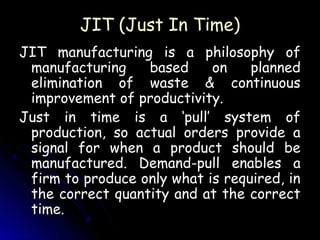
just in time
- 1. JIT (Just In Time) JIT manufacturing is a philosophy of manufacturing based on planned elimination of waste & continuous improvement of productivity. Just in time is a ‘pull’ system of production, so actual orders provide a signal for when a product should be manufactured. Demand-pull enables a firm to produce only what is required, in the correct quantity and at the correct time.
- 2. Advantages of JIT 1. Lower stock holding means a reduction in storage space which saves rent and insurance costs 2. As stock is only obtained when it is needed, less working capital is tied up in stock 3. There is less likelihood of stock perishing, becoming obsolete or out of date 4. Avoids the build-up of unsold finished product that can occur with sudden changes in demand 5. Less time is spent on checking and re-working the product of others as the emphasis is on getting the work right first time Disadvantages of JIT 1. Production is very reliant on suppliers and if stock is not delivered on time, the whole production schedule can be delayed 2. There is no spare finished product available to meet unexpected orders, because all product is made to meet actual orders – however, JIT is a very responsive method of production
- 3. JIT elements 1. Product design element 2. Process design element 3. Personnel/organizational elements 4. Manufacturing planning and control Three elements of product design are key to JIT systems: 1. Standard parts 2. Modular design 3. Quality Personnel Organizational Elements- 1. Workers as assets 2. Cross-trained workers 3. Continuous improvement 4. Cost accounting 5. Leadership/project management
- 4. Process Design element- 1. Small lot sizes 2. Setup time reduction 3. Manufacturing cells 4. Limited work in process 5. Quality improvement 6. Production flexibility 7. Little inventory storage Manufacturing Planning and Control Five elements of manufacturing planning and control are particularly important for JIT systems: 1. Level loading 2. Pull systems 3. Visual systems 4. Close vendor relationships 5. Reduced transaction processing
- 5. Kanban Kanban is the Japanese word for card The card is an authorization for the next container of material to be produced A sequence of kanbans pulls material through the process Many different sorts of signals are used, but the system is still called a kanban
- 6. Kanban 1. User removes a standard sized container 2. Signal is seen by the producing department as authorization to replenish Signal marker on boxes Figure 16.8 Part numbers mark location
- 7. Kanban Kanban Finished Customer goods order Work cell Ship Raw Kanban Final Kanban Material assembly Supplier Kanban Kanban Sub- Purchased assembly Parts Kanban Supplier Figure 16.9
- 8. More Kanban When the producer and user are not in visual contact, a card can be used When the producer and user are in visual contact, a light or flag or empty spot on the floor may be adequate Since several components may be required, several different kanban techniques may be employed
- 9. More Kanban Usually each card controls a specific quantity or parts Multiple card systems may be used if there are several components or different lot sizes In an MRP system, the schedule can be thought of as a build authorization and the kanban a type of pull system that initiates actual production
- 10. The Number of Kanban Cards or Containers Need to know the lead time needed to produce a container of parts Need to know the amount of safety stock needed Demand during Safety Number of kanbans lead time + stock (containers) = Size of container
- 11. Number of Kanbans Example Daily demand = 500 cakes Production lead time = 2 days (Wait time + Material handling time + Processing time) Safety stock = 1/2 day Container size = 250 cakes Demand during lead time = 2 days x 500 cakes = 1,000 1,000 + 250 Number of kanbans = 250 =5
- 12. Advantages of Kanban Allow only limited amount of faulty or delayed material Problems are immediately evident Puts downward pressure on bad aspects of inventory Standardized containers reduce weight, disposal costs, wasted space, and labor
